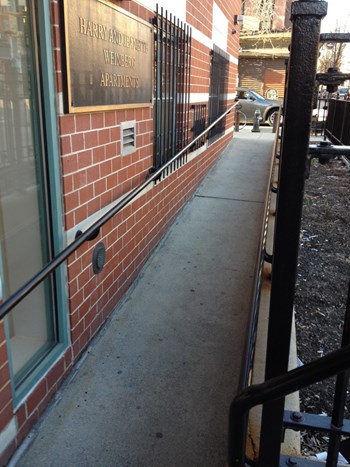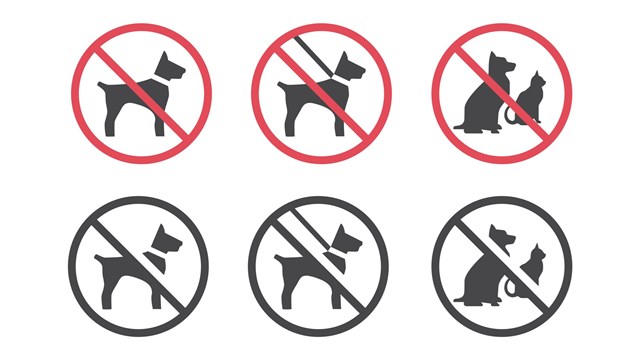
For some New Yorkers planning their daily errands and activities can be as logistically difficult as mountain climbing. These New Yorkers are, of course, those with disabilities, the elderly or anyone whose mobility has been compromised by illness or injury—even temporarily—getting into or out of their own buildings can feel like a monumental task...like climbing a mountain.
Legally, however there are laws in place that are supposed to provide protection and grant those with disabilities rights that would help make daily life a little bit easier. One law, in particular, is Title III of the Americans with Disabilities Act of 1990 (ADA). This law states that owners of certain buildings must remove barriers and provide people with disabilities with access equal to or similar to that available to the general public.
Similarly, another law administered by the New York City Commission on Human Rights (CCHR) is the city's Human Rights Law—this law provides further protection for those who are disabled. The law protects the rights of people with disabilities by requiring that landlords and management of co-ops and condominiums reasonably accommodate the needs of disabled tenants, shareholders or owners.
Reasonable accommodation can be structural, such as a ramp at the primary entrance to provide wheelchair/walker access, or installing grab-bars in public/community bathrooms. Reasonable accommodation can also involve policy or rule changes, such as permitting a tenant who is blind, physically disabled, or has a psychological disability to have a guide dog, service dog or a companion animal despite a building's “no pets” policy. The Human Rights law provides guidance in assessing requests for reasonable accommodation, taking into account the nature and cost of the proposed accommodation and the financial resources of the landlord or building.
Interpretation of the Law
As with many laws however, deciphering the ADA's legalese can be complicated—not fully understanding the laws applications can result in accidental non-compliance. For example, in some cases, managers and boards in the city's older buildings often mistakenly think they are exempt from these laws, believing that the laws are solely meant for new construction. Others may be baffled by the technical requirements of these laws, and still others equate accessibility with big budgets that they may not have at their disposal.
Joshua S. C. Parkhurst, a partner with the New York City-based law firm of Cary Kane, LLP, notes that, “The ADA provides a whole set of technical regulations regarding accessibility, the statute requires that the building be accessible for those with disabilities. As to what that means there is a whole bevy of regulations.” He points out that these regulations are why, “generally you'll see many buildings now with ramps and other accommodations for those with accessibility issues.”
The question that many building managers and board members face is how far does the building have to go in providing “reasonable” accommodations?
According to Parkhurst, “The statute itself is broad, the accessibility guidelines do provide specifics, a lot of specifics, the regulations must be reviewed very carefully... the guidelines regulate even the placement of ATMs, saunas, steam rooms, laundry rooms. The guidelines’ goal is to make it so that most people with disabilities are able to utilize the facilities of the building.”
Though these guidelines are in place to insure accessibility, that doesn't necessarily mean that a building must undertake massive renovations to meet the requirements of the statute.
“Generally there is no need to change the building as existing,” says Parkhurst, “but once alterations are being made they then have to make them so that the building is accessible.”
David J. Byrne, a shareholder and co-chair of the Community Associations Group for the law firm of Stark and Stark, which has offices throughout New Jersey and New York, agrees, “Generally speaking, the ADA is relevant in the condominium/co-op context in only the rehabilitation and/or renovation of existing facilities, etc., and only to the extent that said rehabilitation and/or renovation is of a certain significance.”
Byrne points out that, “The ADA certainly is relevant to the creation of a new building. The United States Fair Housing Act (and any relevant city and/or state anti-discrimination codes) is typically more relevant [regarding new construction].”
The key word here is renovation, says Parkhurst. “If you have a building that's not completely accessible,” he says, “and you are making changes to the front entrance in any regard, that's when you have to put the ramp in. There's something of a rule of reason when it comes to reasonable accommodation, a good rule of thumb is that when you’re making changes to something you've got to change it in a way that it will then be ADA compliant, any addition, any alteration.”
“What some people might consider regular maintenance,” says Parkhurst, “may in fact trigger the alteration. For example, if the stairs to your entrance need repair, unless it's a real tiny patch-up job, there's a very good chance that it will trigger ADA and you'll need to meet the accessibility requirements, to the point that once you have to make the alteration or the addition, you must take advantage of that to include accessibility, even though sometimes making it accessible might become a project on top of what you were planning on doing.”
Help for All
To help make the process smoother, there are several city-based organizations and offices where residents, management and boards can turn to for assistance and help in complying with the ADA. The CCHR’s Law Enforcement Bureau and the Mayor's Office for People with Disabilities are excellent resources for assistance.
The CCHR’s Law Enforcement Bureau says that the biggest problem faced under the rules of the ADA is the belief that older buildings are grandfathered out of the law and thus not required to make changes. The goal of the bureau is to make sure that every building that can be made accessible in a reasonable fashion—if there is a unit owner that requires it—be made accessible.
According to the city’s Human Rights law, disabled residents who need accommodation should inform the building manager and identify the type of accommodation needed. A note from a medical doctor or other health care professional may be required, but medical records are not necessarily required.
Non-Compliance? What Happens?
In spite of the fact that there are specific federal and state laws on disabled access, some managers and building owners refuse to make required exterior alterations for disabled residents, leading to dissatisfied unit owners, possible litigation and hefty fines.
The CCHR’s Law Enforcement Bureau tries to intervene first, without resorting to formal complaints and litigation. The bureau believes that the individual that requires accommodation receive it as soon as possible, so bureau administrators try to reach out to the building management, owner or board and ask that the building be made accessible.
In doing this, the bureau officially reviews the case to determine if the resident needs the accommodation and if that accommodation is reasonable—both financially and physically—for the building to make. The mayor's office can grant waivers to buildings and boards when a request for accessibility alterations outstrips anything the building is able to provide, either structurally or financially.
Parkhurst gives an example. “If you have a prewar walk-up, and a disabled person comes and says that they want to purchase the top apartment, you don't have to completely gut the building to put in an elevator.” That would be unreasonable—both physically and financially.
If the accommodation is determined to be reasonable and the building management and/or board refuse to comply with the Mayor's Office for People with Disabilities, the case is then referred to the CCHR. Those who refuse a hearing before the CCHR will have a complaint filed against the building. The building will then have 30 days to comply or an investigation will be initiated.
In the rare event that a request continues to be refused, the case may be sent to the Department of Justice (DOJ), which relies on a group known as the Key Bridge Foundation to mediate a solution. The foundation is a non-profit organization underwritten by the DOJ and organized to handle complaints filed with the DOJ under Title III of the ADA.
According to the DOJ website, courts may levy civil penalties only in cases brought by the DOJ—not by private litigants. The department only seeks such penalties when the violation is substantial and the business has shown bad faith. This can take many forms, including hostile acts against people with disabilities, a long-term failure to inquire about what the ADA requires, or sustained resistance to voluntary compliance.
Compliance 101
James Boydston, the president of Handi-Lift, a company based in Carlstadt, New Jersey, that makes accessibility aids for disabled individuals throughout the tri-state area, sees many situations where building manager and boards approach his company because a unit owner and the building manager/board are at the brink of a lawsuit.
“Many condos and co-ops have historical buildings that they don't want to change the look of or put anything permanent in,” says Boydston, “so we are asked to make temporary accommodations, such as portable wheelchair lifts.”
However, Boydston says that these products are a temporary answer, as they do not meet ADA requirements. “The ADA wants the wheelchair unit owner to be able to get in and out without assistance.”
As more Baby-Boomers age and require accommodations in order to enjoy their homes and common areas, ADA compliance may soon become a non-issue. The demand for accessible housing will increase and ADA-compliant features can be used as strong marketing tools to a 55-and over population.
Many developers and building managers understand that it's in their own best interest to provide accommodations for disabled unit owners. In doing so, they not only raise the sense of community in their buildings but also let all residents know that they’re valued—regardless of their mobility.
J.M. Wilson is a freelance writer and a frequent contributor to The Cooperator.









4 Comments
Leave a Comment